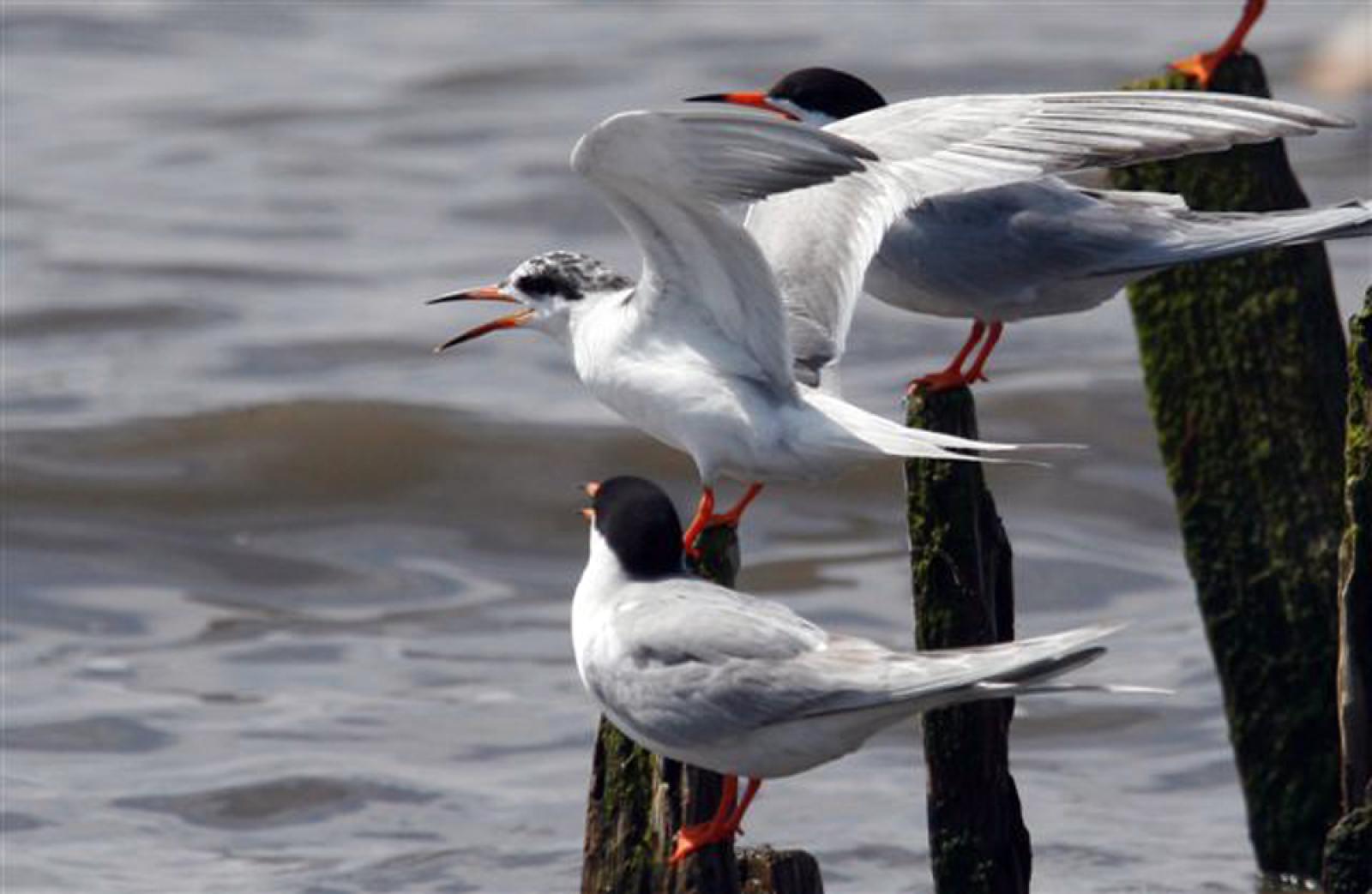Bird watching or birding, you may call it what you wish, is great hobby, occupation, form of relaxation, and more than anything else is an ongoing education. The learning experience involved in birding is one that has kept me hooked on watching, reading about, talking to others about, and surfing the net for information about birds for lo these many years.
Last Friday, May 29, Barbara Pesch and I were invited by Warren Woessner of Minnesota and Edgartown to bird Norton Point. Not having four-wheel drive vehicles and hearing that Warren had seen a black tern on Norton Point the day before, Barbara and I jumped at the opportunity to check out the shorebirds and terns along Katama/Norton Point beaches. The changes that had occurred to the beach and the opening or cut over the winter were of interest to all of us as well.
The roadways on the beach were well marked and tern nesting areas were roped off. Piping plover enclosures had been built in a couple of areas. There were still plenty of areas to access Katama Bay, and the Atlantic Beach side was wide open for surfcasters and beach lovers. We spotted a nice variety of shorebirds including American oystercatchers, dunlin, semipalmated sandpipers, sanderlings, black-bellied plovers and ruddy turnstones. It was interesting to hear Warren comment that he rarely sees sanderlings in breeding plumage in Minnesota.
Just before the wide expanse of beach before the cut, is a sandflat stretching out into Katama Bay. The flat was covered with terns. We stopped and started looking at the congregation hoping to find an Arctic tern. As we scanned we found least terns with silverside minnows drooping off their bills. The fish appeared almost as large as the terns themselves. The males with fish “in hand” would waddle up to their lady loves in hopes of encouraging them to mate. Next to the least terns were common terns appearing almost twice the size. Then as we scanned further we found what looked like a common tern that had fallen into a vat of pink dye. Their breasts had a rosy blush. You guessed it, they were roseate terns. We never did find an Arctic tern, but Warren casually said, “There is a Forster’s tern.” Barbara and I in unison said, “Where?”
Now the education part kicks in. Neither Barbara nor I could remember seeing a Forster’s tern in breeding plumage. The Forster’s tern for us was a fall/early winter visitor to the Vineyard. So Warren proceeded to fill us in on the details that separate Forster’s terns from common and roseate. The bill color of orange with a black tip separated it from the roseate terns black bill; however this didn’t help with the common terns which also have the orange and black-tipped bill. Warren made us look at the breasts of both species of terns with orange bills. One had a strikingly white breast and the other a gray breast almost the same color as its wings. The tern with the white breast and two-toned bill is the Forster’s tern and the common tern has a gray breast and belly.
Warren continued to say that Forster’s terns are the common tern of Minnesota and common terns are not. It is great to bird with someone from another part of this country that is familiar with species which we may not see on the Vineyard in breeding plumage. You learn something each day if you keep your eyes and ears open! Thanks Warren and happy birthday.
Bird Sightings
Larry Hepler and Alice Early heard whip-poor-will at their Quansoo home the evening and early morning of May 23 and May 24.
Sarah Mayhew had her first ever indigo bunting at her West Tisbury house on May 26.
Warren Woessner birded Waskosim’s Rock on May 26 and spotted not one but two Acadian flycatchers along the brook. He also saw a male scarlet tanager. On May 28 Warren spotted a black tern at Katama in with the large flock of terns loafing on the sandflat. May 30 Warren birded the Oak Bluffs Pumping Station and found a female blackpoll warbler, two black-crowned night herons and a pair of orchard orioles that he felt were nesting.
John Liller and his wife, Kim Kastler, birded various locations on Chappaquiddick on May 30. They heard tufted titmice singing at the Brine’s Pond Reserve. They checked out the merlin nest with Dick Jennings and were upset to find that the merlins had abandoned the nest. Dick will check again in hopes that these falcons will return. At Little Beach in Edgartown John and Kim heard two white-eyed vireos singing on May 29 but couldn’t find them the next day. To me the most surprising bird John and Kim noted was a singing northern waterthrush on Chappaquiddick. We have very few spring records for northern waterthrush and the few we have are usually gone by mid May.
Felix Neck Wildlife Sanctuary called to say that along with the regulars, they had a great egret show up in the marshes on June 2.
Rob Bierregaard and Dick Jennings reported that the osprey Conomo that was tagged in 2007 made it back to the Vineyard finally on May 30th. Strangely a couple of days later Conomo disappeared. Seems he went to the northeast corner of Connecticut to some lakes that are a magnet to Vineyard osprey. As Rob stated, these spots are in their memory banks and when the fishing isn’t that good on the Vineyard they head to the fresh water lakes in Connecticut for a spell. Stay tuned for more Conomo information.
Please report your bird sightings to the Martha’s Vineyard Bird Hotline at 508-627-4922 or e-mail to birds@mvgazette.com.







Comments
Comment policy »